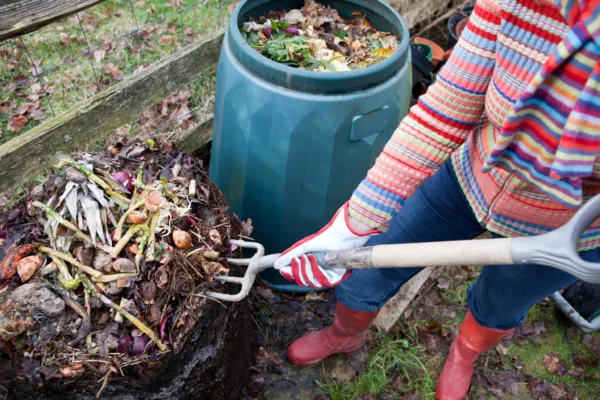The decomposition of kitchen and yard waste into finished compost can take anywhere from a few months to a few years depending on how well you manage the balancing the food (greens and browns), water, and air.
How to Harvest
How you harvest your mature compost will be dependent on what style of compost bin you use. If you have a single compost bin, you will likely have to remove the top portion of the pile to get to the material that is ready for harvesting (it falls to the bottom). If you have several bins, or a multi-bin system, you can use one section or bin to let compost fully mature, and add new materials to the other(s). That way you can simply empty out the entire bin when its contents are mature!
With a single bin you will either have to:
- Move your bin over adjacent to it’s current location and transfer the unfinished material back into the bin. You can then harvest the remaining material.
- Remove the top portion of the pile. Once you have harvested the finished compost from below, you can then shovel the contents back into the bin and start adding new material on top.
When to Harvest
Generally compost is ready to be harvested when the finished product is a rich dark brown color, smells like earth, and crumbles in your hand. Some signs that it may not be ready include:
- Recognizable food content still visible
- The pile is still warm. This means that it is still working.
- There are still lots of large lumps in the pile.
If any of the above are noticeable, give it a few more weeks and check it again. If it looks ready but you still have twigs and other hard materials like fruit pits it can still be considered finished. You may however need to screen it before using it, depending on what you intend to use it for. Screened compost makes a great top dressing for your lawn.
Many people ask us is it better to harvest compost in the spring or the fall? Generally we recommend harvesting in the fall because if compost is used before it has fully mature, the microorganisms may rob the soil and plants of nitrogen in order to finish the process. Spreading your compost in the fall will ensure that by spring any issues related to compost maturity will be eliminated.
How to use finished compost
Finished compost can be used both outdoors and indoors as a natural fertilizer for plants. Mix it in the soil before planting, or use it to top dress your indoor and outdoor plants, including your lawn and shrubs.
Compost can also be used to make a rich liquid fertilizer called compost tea which can not only be used to provide nutrients for your plants, it can also suppress leaf disease when sprayed directly on the plant leaves.
How Much to Use
You generally don’t have to worry about adding too much compost to your garden, in fact most people have the opposite problem, they don’t have as much as they need.
Place one to three inches of compost over the garden area in the fall and then dig it into the top 4 to 8 inches of the soil. The added advantage of digging it in during the fall is that the clumps of soil that you leave in your garden will freeze over the winter. The formation of ice in the soil will literally explode the clumps and in most cases you will only need a rake or hoe in the spring to break up the remaining clumps and level your garden area.
For indoor plants you can use up to about 25% in your potting mix or just apply liberally to the top of existing plants. If you are worried about bugs from you outdoor compost invading your home, simply bake the compost in the oven to make it bug free.



